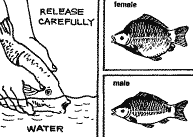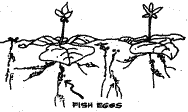



About 300 000 ha of wheat fields around Jabalpur, Madhya Pradesh in India are virtual rainfed ponds (havelis) from July to October. There being no source of irrigation, rainwater is impounded in these fields (with about 1 m high dikes) until the onset of winter when they are drained, ploughed and the wheat is sown. This period lasts for 3-4 months wherein the field is used for common carp seed production. Based on the input requirements for a 0.4 ha field, these procedures could be followed.
1. Select a field near the road but away from a floodprone zone. Check the dikes and put meshed screens on the inlets and outlets, if provided.
 |
 |
2. Spray an emulsion of 20 litres diesel and 7 kg of cheap washing soap on the water surface to kill predatory aquatic insects as soon as about 60-80 cm of water gets accumulated in the field.
3. After spraying, release four healthy and fully ripe females along with an equal number of males, each weighing about 1 kg. Provide 2-3 kg of Hydrilla or Eichornia at three or four places in the field. A fully ripe, healthy female can be distinguished by its swollen, bulging abdomen and a reddish genital region which is pit-like in the male. The males also ooze milk with gentle pressure on their abdomen.
4. The fish breed within 24-48 hours of stocking or take a day or two more, if they are not fully ripe. The eggs are laid on the weeds and hatch within 48-72 hours.
5. Harvesting can be done after 15-20 days. Approximate yield is 100 000 fry of about 25-30 mm size. If the field is fertilized with 2 000 kg cow dung and the fish are fed with an artificial feed comprising groundnut oil cake and rice bran (1:1 by weight), the survival is high and the growth is fast.
6. The remaining fry attain a size of 40-60 mm by the time the fields are to be drained when these (about 20 000 fingerlings) are also harvested.
 |
 |
Budget (in rupee) for carp in 0.4 ha haveli wheat fields
Costs |
|
Cost of 8 kg live broodfish (4 females and 4 males; 1 kg each) at Rs25/kg |
200 |
Transport |
200 |
Soap oil treatment |
125 |
Total costs |
525 |
Income |
|
Sale of 50 000 fry at Rs10/1 000 |
500 |
Sale of 20 000 fingerlings at Rs100/1 000 |
2 000 |
Sale of 6 kg of fish at Rs15/kg |
90 |
Total income |
2 590 |
Balance |
2 065 |
Net income/ha |
5 162 |
Issues for further consideration In considering the adoption of this technology, further information may be required. Who buys the seed and in which quantities? What are the alternative sources of fish seed (if any)? What role do the different members of the household have in the activity? Where do farmers producing the seed obtain their broodfish from? What type, rates and methods of fertilization and feeding are needed? In estimating the economics of the system, cost for these would have to be included. The technology described here is used in certain parts of India. It can also be adapted to areas with demand for carp seed and can be performed by smallholder farm families to enhance their income. |